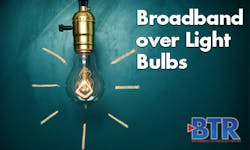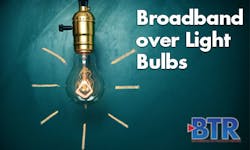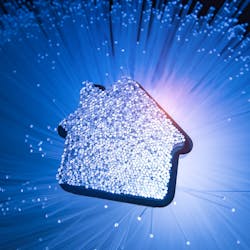One "exciting new contender" is LiFi, said Josh Redmore, lead architect, wireless network optimization, CableLabs. With LiFi, modulations of free-space beams of light are used to transmit signals. The principle is similar to WiFi, only the frequency band is higher. Whereas WiFi operates at 2.4 and 5 GHz, LiFi utilizes the 430 THz - 770 THz band. The result is that LiFi offers capacity of about 340 THz, compared to WiFi's less than 1 GHz.
"To give you an idea of just how large a difference this increase in bandwidth is, it's close to the same difference between the mass of the Earth and the Sun," Redmore wrote in a recent blog.
The idea is to manufacture LiFi-enabled light bulbs that work like existing ones and screw into the fixtures consumers already have at home. CableLabs currently has fully functioning prototypes of a single-channel LiFi system that can deliver 300 Mbps. This particular version is an Ethernet USB adaptor, which is "extremely" plug-and-play, Redmore said. Whereas the prototype uses a single wavelength, the goal is to be able to use multiple wavelengths with multiple endpoints.
As for an endpoint device, Apple (NASDAQ:AAPL) is said to be researching incorporating LiFi into its mobile devices. The company has not yet spoken publically about this. Rather, in the iOS 9.1 library cache file, there are references to LiFi capability, according to Apple Insider.
"The only information we have is from looking at their code and the tags that (Apple) uses. It is entirely speculative, but it seems to point in that direction," Redmore said. He noted that smartphones already have a light emitter and light detector by way of the camera and its flash.
To network the LiFi products together within the home, the system would need to have a distribution network, like the electrical wiring. "You can achieve whole-home coverage. Anywhere there is light, there is connectivity," Redmore wrote.
There currently are no standards for LiFi. This means vendors could utilize different blinking patterns and, therefore, might not be able to work with products manufactured by someone else. Other challenges include the signal-to-noise ratio.
"There is light everywhere that you are wanting to use the device. Additional work needs to be done on how to filter out what is meaningful and what is noise," Redmore said.
The idea of using light bulbs for in-home networking isn't new. In 2013, Fraunhofer HHI presented an idea for high-speed Internet via light bulbs to the ITU. That system used ordinary LED light bulbs rather than special LiFi-enabled ones and achieved data rates of up to 800 Mbps under lab conditions. Fraunhofer sells a wireless LAN system based on that technology today.






